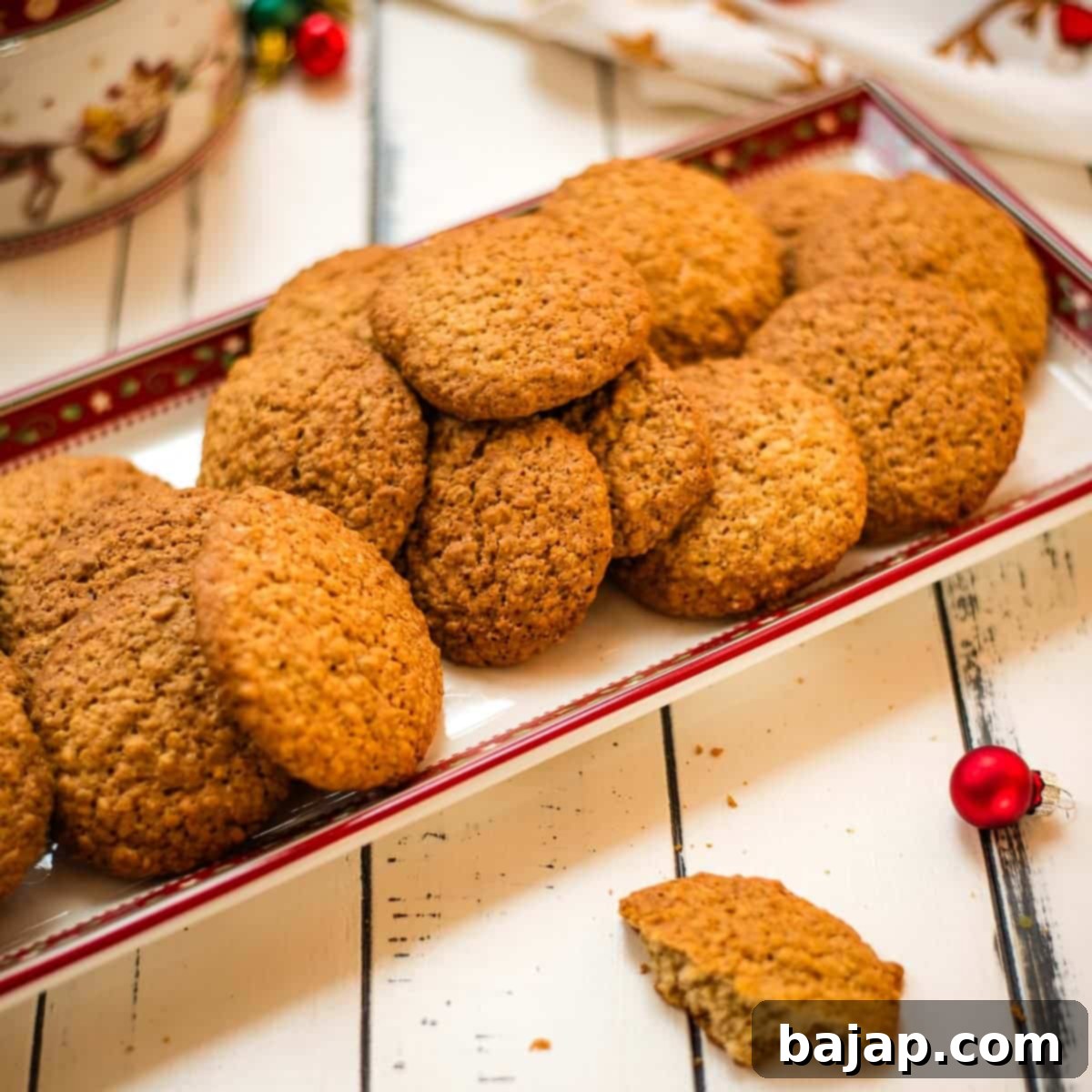Irresistible Oatmeal Cinnamon Cookies without Brown Sugar: Your New Favorite Easy Recipe!
When you bite into these delightful oatmeal cinnamon cookies, fresh out of the oven, you’ll experience a warmth and comfort that feels just like a loving hug. Their perfectly crispy texture and pleasing sweetness make them an instant favorite – especially with my daughter! The best part? This recipe is so incredibly simple to prepare that even little hands can help in the kitchen, making it a wonderful family activity.
These aren’t just any oatmeal cookies; they are specifically crafted to achieve a fantastic texture and flavor profile without the need for brown sugar. This makes them a perfect alternative when you’re out of brown sugar or simply prefer a lighter, yet equally satisfying, cookie. Get ready to discover your new go-to recipe!
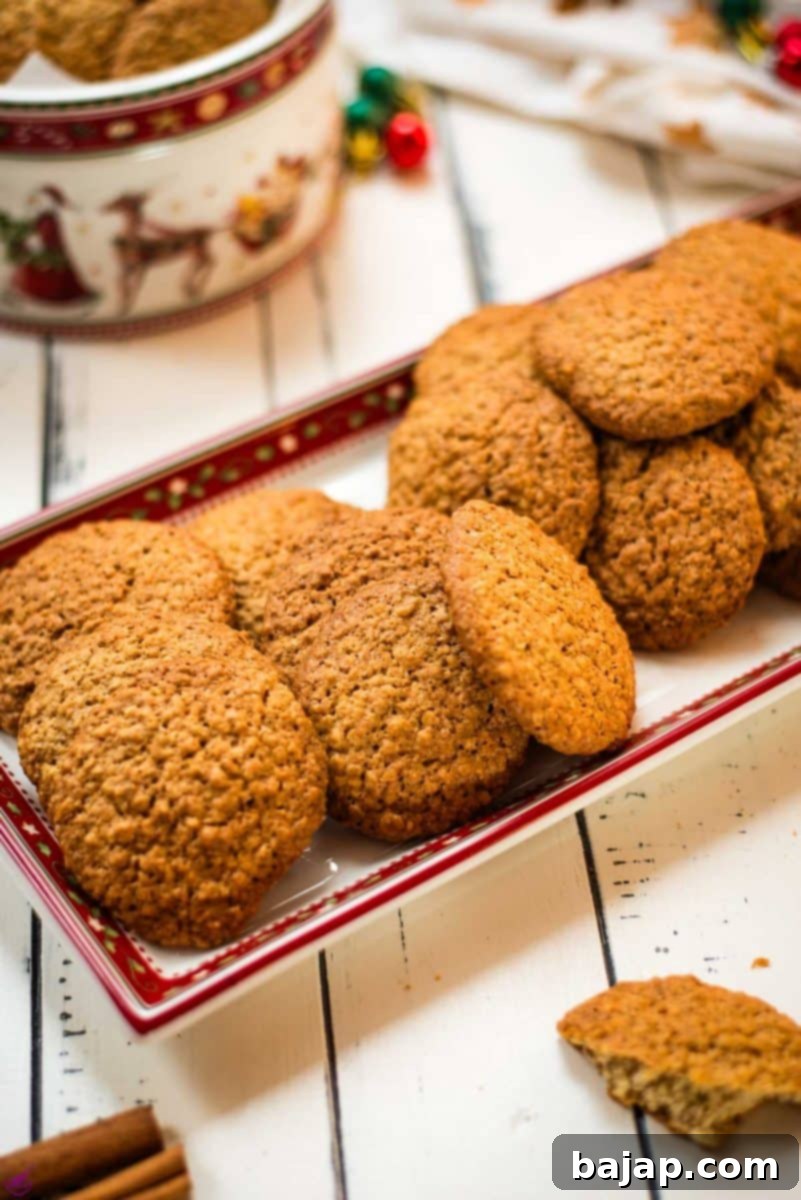
You’ll also adore these cookies for their impressive shelf life, allowing them to remain delicious for several weeks when stored properly in a cookie jar. They’re the ideal pick-me-up treat after a long day, whether you enjoy them with a cup of tea, coffee, or milk. That is, of course, if you manage not to devour them all immediately after they cool!
If you’re eager to try this truly delicious and unique recipe for yourself, keep reading! We’ll guide you through every step, from ingredients to baking and storage, ensuring your success in creating these much-loved oatmeal cinnamon cookies without brown sugar.
🌟 Why You’ll Adore These Cookies
Beyond being incredibly tasty, these oatmeal cinnamon cookies offer several reasons to become a staple in your recipe collection:
- No Brown Sugar Needed: Perfect when you’re in a pinch or prefer a different sweetness profile.
- Simple Ingredients: Uses common pantry staples you likely already have on hand.
- Quick & Easy: Minimal prep time and straightforward instructions, even for novice bakers.
- Long-Lasting Freshness: They stay wonderfully fresh and delicious for weeks in an airtight container.
- Versatile: Easily customizable with various add-ins like dried fruit or chocolate chips.
- Family-Friendly: A delightful treat that kids and adults alike will love, and simple enough for children to help make.
- Comforting Aroma & Taste: The combination of warm cinnamon and wholesome oats creates a truly comforting experience.
[feast_advanced_jump_to]
🥘 Key Ingredients for Your Perfect Oatmeal Cookies
Crafting these wonderful oatmeal cinnamon cookies without brown sugar requires a selection of simple, yet essential ingredients. Each component plays a crucial role in achieving the desired flavor and texture. Here’s a closer look at what you’ll need and why:
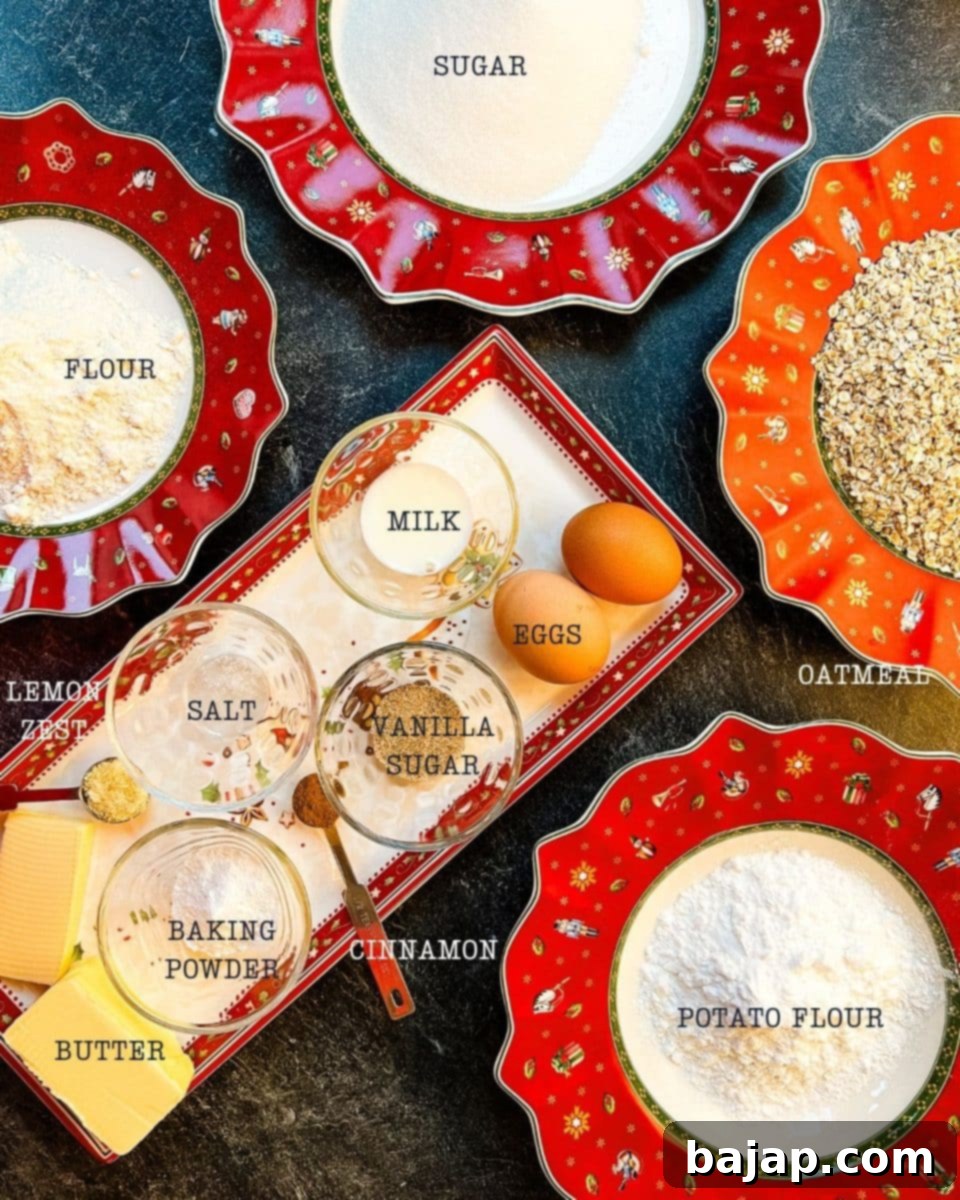
- Unsalted Butter (soft): Using softened butter ensures it creams smoothly with sugar, creating a tender cookie. Unsalted butter gives you control over the overall saltiness of your bake.
- Oatmeal: Rolled oats (old-fashioned oats) are highly recommended for their chewy texture and ability to hold up well in the cookie dough. Instant or quick oats can be used in a pinch but may result in a slightly different texture.
- Cake Flour: This is a secret ingredient for a tender, light cookie! Cake flour has a lower protein content than all-purpose flour, which helps prevent the cookies from becoming tough.
- Baking Powder: Our leavening agent, ensuring the cookies rise nicely and achieve that pleasant, slightly airy crispness.
- Potato Flour: This is a star player in our brown sugar-free recipe. Potato flour acts as a thickener and moisture retainer, helping to replicate the tender, slightly chewy texture that brown sugar often contributes to cookies. It’s a fantastic substitute for achieving that desired consistency.
- Granulated Sugar: The primary sweetener, contributing to the cookie’s crispness and classic sweet flavor.
- Vanilla Sugar (store bought or homemade): Adds a wonderful aromatic depth and sweetness that complements the cinnamon beautifully. Homemade vanilla sugar is easy to make and often provides a richer flavor.
- Kosher Salt: A small pinch of salt enhances all the other flavors, balancing the sweetness and bringing out the nuances of the cinnamon and vanilla.
- Ground Cinnamon: The key spice! For the best flavor and health benefits, reach for Ceylon cinnamon when buying. Ceylon cinnamon, often called “true cinnamon,” is more expensive than the common Cassia cinnamon but contains hardly any Coumarin. Coumarin, in large amounts, can be toxic and should not be consumed in excess, especially by pregnant women. Ceylon offers a more delicate, complex, and sweeter flavor, making your cookies truly stand out.
- Lemon Zest: A surprising but delightful addition! The finely grated zest of a lemon adds a bright, fresh note that cuts through the sweetness and cinnamon, elevating the overall flavor profile. Don’t skip it!
- Eggs: Act as a binder, holding all the ingredients together and adding richness and structure to the cookies.
- Milk: Provides essential moisture, helping to create a cohesive dough and a tender crumb in the final cookie.
For precise measurements and full instructions, see the recipe card below.
🔪 Step-by-Step Instructions for Baking Perfection
Baking these delicious oatmeal cinnamon cookies is a straightforward and rewarding process. Follow these detailed steps to ensure perfectly crisp and flavorful results every time:
The first thing you’ll do to get started on these delicious oatmeal cookies is to gently melt your softened butter in a small saucepan over low heat. Be careful not to brown or burn it; we just want it liquid and warm.
Next, transfer your oatmeal into a medium-sized mixing bowl. Carefully pour the hot, melted butter over the oats. Using a sturdy spoon or spatula, mix them thoroughly until the butter and oatmeal are completely well combined and the oats are evenly coated. This step helps soften the oats slightly and infuse them with butter flavor.
Once the butter and oatmeal mixture is ready, it’s time to add the dry ingredients. Carefully sift in your cake flour and baking powder directly over the oat mixture. Sifting helps to aerate the flour and ensures there are no lumps, leading to a smoother, more uniform dough and a lighter cookie texture.
After the flour and baking powder have been sifted into the mix, you can proceed to add the rest of your dry ingredients to the oatmeal: potato flour, granulated sugar, vanilla sugar, kosher salt, ground cinnamon, and fresh lemon zest. Mix everything gently until just combined. Overmixing at this stage can develop the gluten in the flour too much, leading to tough cookies.
Now, it’s time for the wet ingredients. Add the eggs and milk to the mixture. Using an electric mixer fitted with a flat beater attachment, mix on low speed until a cohesive dough forms. Again, mix only until the ingredients are incorporated; a few streaks of flour are acceptable.
While your dough rests for a moment, preheat your oven to 180 °C / 356 °F (convection oven setting is ideal for even baking). Line your baking tray with baking paper or parchment paper to prevent sticking and ensure easy cleanup.
Using a small cookie scoop (ideally a 1-tablespoon size, as specified in the recipe card), scoop out portions of the oatmeal mixture. Roll them lightly into balls if desired, then place them onto the prepared baking sheet. Ensure there’s enough space between each cookie – aim for approximately 5 rows with four cookies per row – to allow for even heat circulation and spreading. Bake for 25-30 minutes, or until the edges are lightly golden brown and the centers are set. The exact time may vary based on your oven and cookie size, so keep an eye on them!
Once your cookies have achieved that perfectly golden-brown hue, carefully remove the baking sheet from the oven. Resist the urge to dig in right away! Transfer your finished cookies onto a wire rack to cool completely. Cooling on a rack allows air to circulate around them, preventing them from becoming soggy and helping them achieve their desired crisp texture. After they’ve cooled down sufficiently, all that’s left to do is savor your delicious creations and say, “Bon Appetit!”
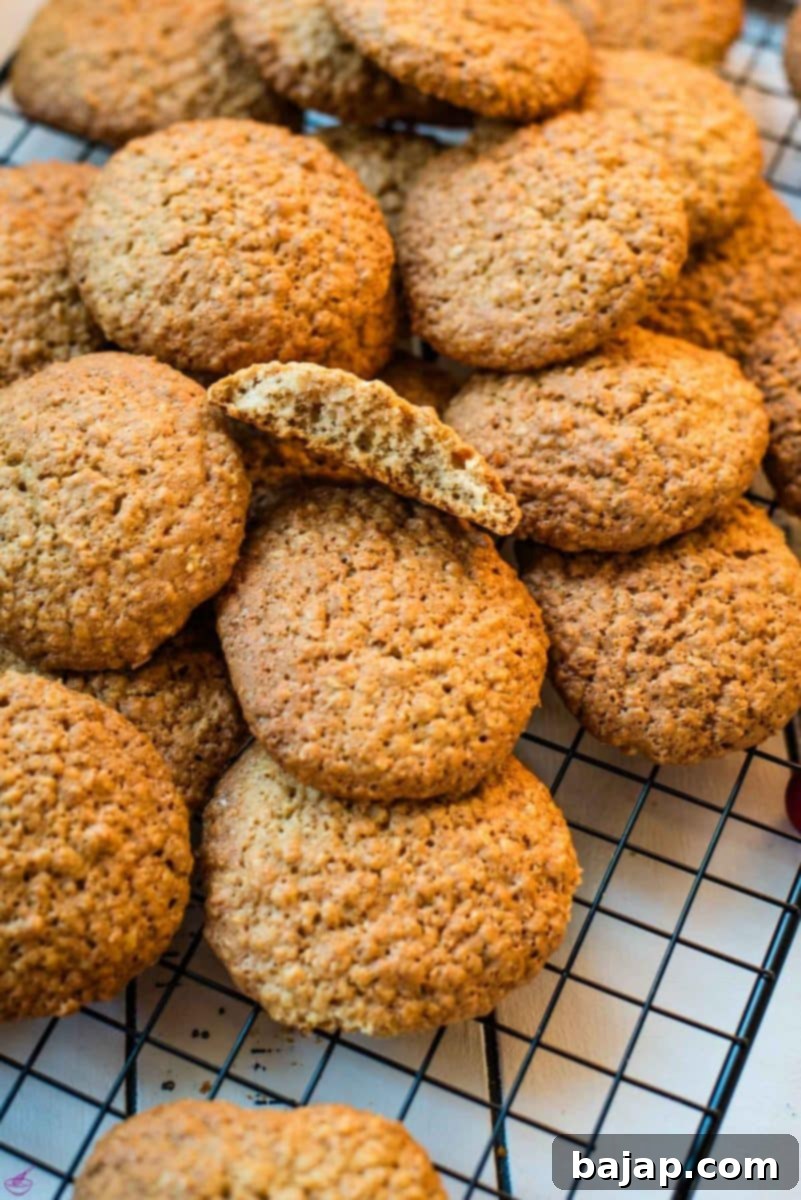
These crispy, sweet oatmeal cinnamon cookies pair wonderfully with a warm beverage. For a truly unique experience, enjoy them with a delicious cup of sage tea. Check out this article to learn how to make sage tea!
🍪 Tips for Perfect Oatmeal Cookies Every Time
Achieving the ideal oatmeal cookie is simple with a few helpful pointers:
- Room Temperature Butter: Ensure your butter is truly softened (but not melted) for the best creaming results. This helps incorporate air and leads to a lighter texture.
- Don’t Overmix: Once the dry ingredients are added, mix just until combined. Overmixing can develop gluten, making your cookies tough.
- Accurate Measurements: Baking is a science! Use proper measuring techniques, especially for flour (spoon and level, don’t scoop directly from the bag).
- Cookie Scoop for Uniformity: Using a cookie scoop not only makes the process faster but also ensures all your cookies are the same size, leading to even baking.
- Cool Completely: Always let your cookies cool on a wire rack. This stops the baking process and allows them to crisp up properly.
- Adjust Baking Time: Ovens vary! Watch your cookies closely. For crispier cookies, bake a minute or two longer; for slightly softer ones, pull them out when they’re just set.
🍪 Creative Variations for Your Oatmeal Cookies
While these oatmeal cinnamon cookies are fantastic as is, they also serve as an excellent base for various additions and flavor twists. Feel free to get creative and customize your batch!
- Fruity Additions: You can easily vary this recipe by adding extra dry ingredients like plump raisins, tangy dried cranberries, or even chopped dried apricots. Add about ½ to 1 cup of your chosen dried fruit during the final mixing stage.
- Chocolate Lover’s Dream: For those who love a hint of chocolate, stir in ½ to 1 cup of chocolate chips (milk, dark, or white chocolate work beautifully) along with the dry ingredients.
- Nutty Crunch: Add some texture and flavor with chopped nuts such as walnuts, pecans, or almonds. Roughly ½ cup should do the trick.
- Tropical Twist: Shredded coconut (sweetened or unsweetened) can add a delightful chewiness and tropical flavor.
- Extra Spices: Enhance the warmth by adding a pinch of nutmeg, ground cloves, or allspice alongside the cinnamon for a more complex spice profile, especially during the colder months.

Christmas CookieBook!
Snag that Recipe eBook!
Looking for even more cookie inspiration? Get your hands on our exclusive Christmas CookieBook featuring 20 delicious Christmas Cookie recipes!
Yes, please!
🍽 Essential Equipment for Cookie Making
Having the right tools can make your baking experience smoother and more enjoyable. Here’s a list of equipment you’ll need for these oatmeal cinnamon cookies:
- Food Processor (optional but useful): While not strictly necessary, a food processor can be helpful for quickly zesting lemons or even combining some dry ingredients for very large batches.
- Saucepan – small: For gently melting the butter.
- Sieve: Essential for sifting flour and baking powder, ensuring a smooth, lump-free dough.
- Cookie scoop: This is highly recommended for creating uniformly sized cookies, which ensures they bake evenly. I always have three different cookie scoop sizes at home – 1 tablespoon / 0.5 oz, 2 tablespoon / 1 oz, and 3 tablespoon / 1.5 oz. The 1 tablespoon cookie scoop is the one I use most often for this recipe, and the baking times and cookie quantities are adjusted to this size. If you prefer larger cookies, feel free to use the larger sizes. Just keep in mind that the baking time will increase, and the number of cookies will decrease accordingly.
- Mixing Bowl: A large, sturdy mixing bowl is needed to combine all your ingredients.
- Electric Mixer (with flat beater attachment): Makes quick work of mixing the dough evenly without overworking it.
- Baking Tray: You’ll need at least one, possibly two, baking trays to bake all your cookies.
- Baking Paper (Parchment Paper): Prevents sticking and makes cleanup a breeze.
- Wire Rack: Crucial for cooling cookies evenly and ensuring they don’t get soggy on the bottom.
🌡 Storage Solutions for Freshness
One of the many perks of this oatmeal cookie recipe is how well the cookies store. Whether you have a few left over or you baked a large batch specifically for future enjoyment, proper storage will keep them fresh and delicious for weeks!
You can store these cookies in an airtight container – like a charming cookie jar – at room temperature for up to several weeks. This recipe yields about 50 cookies (when using a 1-tablespoon scoop), so it’s likely you’ll wind up with some leftovers to enjoy over time! Ensure the container is truly airtight to prevent them from drying out or becoming stale. A piece of parchment paper between layers can help if stacking.
If you wish to store them for an even longer period, these cookies also freeze beautifully. Once completely cooled, place them in a single layer on a baking sheet to flash freeze for about an hour. Then, transfer the frozen cookies to a freezer-safe bag or container, separating layers with parchment paper. They can be stored in the freezer for up to 3 months. Thaw them at room temperature when ready to enjoy, or warm them slightly in the oven for a “freshly baked” experience!
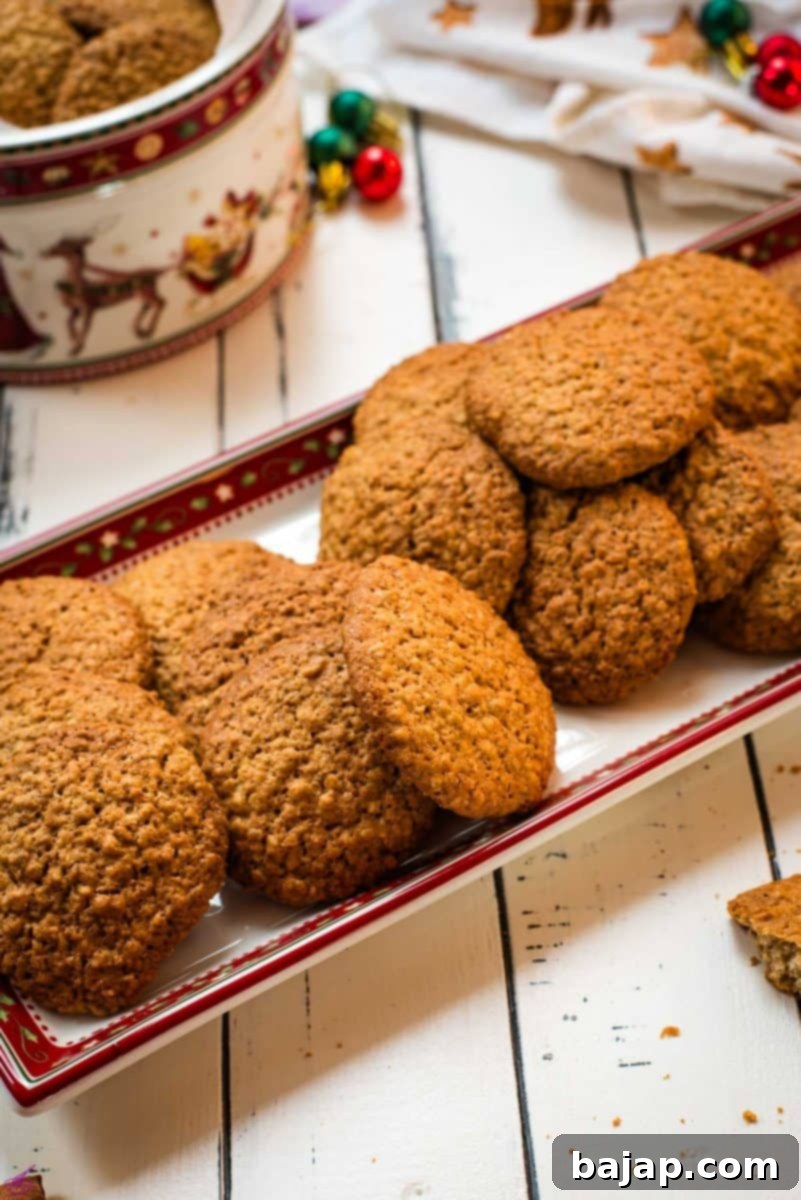
💭 Understanding Brown Sugar and Its Role
Brown sugar is essentially granulated sugar with molasses added back in, which is what gives it its characteristic moist texture, deeper flavor, and light brown hue. It’s often favored in baking for its ability to contribute moisture and chewiness, resulting in softer baked goods compared to white sugar.
It is important to remember that dark brown sugar contains more molasses than light brown sugar, making it denser and slightly richer in flavor. When using brown sugar, you may need to adjust the amount of other liquid ingredients in a recipe, as its moisture content helps create that beloved soft, moist texture. Brown sugar can also be used to replace white sugar in many recipes for a subtle flavor difference, adding notes of caramel and toffee.
However, this recipe proves that you don’t always need brown sugar to achieve a wonderful oatmeal cookie! By skillfully combining other ingredients like potato flour, we mimic some of brown sugar’s textural contributions while achieving a distinct, equally delicious result.
💡 Why Bake Without Brown Sugar?
There are several great reasons to opt for a recipe that doesn’t rely on brown sugar:
- Pantry Availability: Sometimes, you just don’t have brown sugar on hand, and a craving strikes! This recipe ensures you can still enjoy delicious oatmeal cookies.
- Taste Preference: While brown sugar offers a distinct molasses flavor, some prefer the cleaner, crisper sweetness that granulated sugar provides, especially when combined with warm spices like cinnamon and bright lemon zest.
- Dietary Choices: For those monitoring certain types of sugar intake or simply looking to experiment with different sweeteners, this recipe offers a fantastic alternative.
- Unique Texture: The combination of ingredients in this recipe creates a cookie that is beautifully crisp yet still tender, offering a slightly different, appealing texture profile than traditional brown sugar cookies.
🎄 Get in the Holiday Baking Mood
If these comforting cinnamon cookies have you feeling festive, explore more holiday-inspired recipes and tips from our collection:
- How to Decorate a Real Christmas Tree in 11 Steps
- Baking Basics for Christmas Cookies
- Delicious No-Churn Egg Liqueur Parfait
- Cranberry Aperol Spritz
🙋🏻 Frequently Asked Questions About Oatmeal Cookies Without Brown Sugar
In this specific recipe, we successfully use a combination of potato flour and granulated sugar to achieve a wonderful texture and sweetness profile, distinct from brown sugar but equally delightful. Potato flour helps add a tenderness that mimics brown sugar’s moistness. Other variations or substitutions you could consider include adding a tablespoon of molasses to white sugar (to create a homemade brown sugar substitute), or using liquid sweeteners like honey or maple syrup, though these may require adjustments to other liquid ingredients in your recipe to maintain dough consistency.
Typically, brown sugar is crucial for giving cookies that perfect dense, chewy, and slightly crispy texture that white sugar alone can’t achieve. It’s the molasses in brown sugar that provides moisture and contributes to chewiness. Without it, cookies made with only white sugar tend to be crisper and spread more. However, in our recipe, we cleverly substitute its textural role with potato flour, ensuring the cookies are still wonderfully crisp and pleasingly tender, maintaining a delightful texture even without brown sugar.
While brown sugar is often considered a staple in many cookie recipes for its contribution to moisture, chewiness, and flavor, it is absolutely not always necessary. As this recipe demonstrates, with a few clever substitutions and ingredient adjustments, you can achieve equally delicious and satisfying oatmeal cookies that boast a fantastic texture and flavor profile without a single gram of brown sugar.
In cookie recipes, brown sugar serves multiple purposes. Its molasses content makes it hygroscopic, meaning it attracts and retains moisture, leading to a softer, chewier cookie. It also contributes a slightly acidic component which reacts with baking soda to aid in leavening, and its caramel notes add a deeper, more complex flavor profile compared to plain white sugar. Without it, you need to find alternative ways to manage moisture and texture, which we’ve done successfully in this recipe with potato flour.
While rolled oats (old-fashioned oats) are recommended for their robust texture, you can use quick oats or instant oats in this recipe. Be aware that using them might result in a slightly softer, less chewy cookie texture because they are more finely processed and absorb liquids more quickly. The overall flavor will remain consistent.
Absolutely! You can prepare the cookie dough and store it in the refrigerator for up to 3-5 days. Simply wrap it tightly in plastic wrap or place it in an airtight container. When you’re ready to bake, let the dough sit at room temperature for about 15-20 minutes to soften slightly before scooping and baking as usual. This can be a great way to have fresh cookies on demand!
Other Delicious Cookie Recipes for You to Try
If you’ve enjoyed baking these oatmeal cookies, you might be interested in exploring more of our delightful cookie recipes:
- Delicious, Super Quick M and M Cookies
- Austrian Coconut “Busserl” cookies – like from granny
- Divine Leftover Egg Yolk Cookies
- 5 Ingredient Raspberry Cheesecake Thumbprint Cookies
- Chocolate Chip Cookies with Chestnut Flour
If you make this recipe, we’d love to hear how you liked it! Please let us know by giving it a ★★★★★ star rating and leaving a comment below. Your feedback is truly awesome and helps other home bakers. You can also sign up for our Newsletter or follow me on Pinterest or Instagram and share your creation with me. Just tag me @combinegoodflavors and use the hashtag #combinegoodflavors, so I don’t miss your beautiful bakes!
📖 Recipe Card

Oatmeal Cinnamon Cookies without Brown Sugar
Nora
Save RecipeSaved!
Pin Recipe
Equipment
-
Food processor
-
Saucepan small
-
Sieve
-
Cookie scoop
-
Mixing bowl
-
Baking tray
-
Baking Paper
-
Cooling Rack
Ingredients
- ½ Cup Butter soft, unsalted
- 3 ¼ Cup Rolled Oats
- 1 Cup Cake flour
- 3 ¼ teaspoon Baking powder
- 1 Cup Potato flour
- 1 Cup Granulated sugar
- 2 teaspoon Vanilla sugar
- 1 dash Kosher salt
- ½ teaspoon Ground Ceylon Cinnamon
- 1 teaspoon Lemon zest
- 2 Large Eggs
- 3 tablespoon Milk
Instructions
-
Melt ½ Cup Butter in a small saucepan over low heat until just liquid.½ Cup Butter
-
Place 3 ¼ Cup Rolled Oats in a mixing bowl, then pour the hot melted butter over them. Mix thoroughly until the oats are well combined and coated with butter.3 ¼ Cup Oatmeal
-
Sift 1 Cup Cake flour and 3 ¼ teaspoon Baking powder directly into the oatmeal mixture.1 Cup Cake flour, 3 ¼ teaspoon Baking powder
-
Now, add the remaining dry ingredients: 1 Cup Potato flour, 1 Cup Granulated sugar, 2 teaspoon Vanilla sugar, 1 dash Kosher salt, ½ teaspoon Ground cinnamon, and 1 teaspoon Lemon zest to the oatmeal mixture. Mix gently until just combined.1 Cup Potato flour, 1 Cup Granulated sugar, 2 teaspoon Vanilla sugar, 1 dash Kosher salt, ½ teaspoon Ground cinnamon, 1 teaspoon Lemon zest
-
Finally, add 2 Large Eggs and 3 tablespoon Milk. Mix with an electric mixer using a flat beater attachment until a uniform dough forms. Be careful not to overmix.2 Eggs, 3 tablespoon Milk
-
Preheat your oven to 180 °C / 356 °F (convection setting is ideal) and line a baking tray with baking paper.
-
Using a small cookie scoop (1 tablespoon size recommended), scoop out portions of dough, roll into balls if desired, and place them on the prepared baking sheet. Ensure adequate spacing (about 5 rows with four cookies per row). Bake for 25-30 minutes, or until the edges are lightly golden brown.
-
Once baked, carefully transfer the hot cookies to a wire rack to cool completely before enjoying.
Nutrition values are estimates only, using online calculators. Please verify using your own data.

🤎 More Cookie Recipes You Might Also Like
If you loved these oatmeal cinnamon cookies, be sure to check out these other fantastic cookie recipes:
- Chocolate Chip Cookies with Chestnut Flour
- Chocolate Dipped Butter Cookies
- Sour Cream Cookies with Pearl Sugar
- Easy Cut-Out Sugar Cookies {no chill}
⛑️ Important Food Safety Guidelines
Ensuring food safety is paramount when cooking or baking. Please keep these general guidelines in mind to protect yourself and your loved ones:
- Cook all food to a minimum safe internal temperature of 165 °F (74 °C) to eliminate harmful bacteria.
- Avoid cross-contamination by never using the same utensils or cutting boards on cooked food that previously touched raw meat or eggs without thoroughly washing them in between.
- Always wash your hands thoroughly with soap and warm water for at least 20 seconds after touching raw meat, eggs, or unwashed produce.
- Do not leave perishable food sitting out at room temperature for extended periods (generally no more than two hours).
- Never leave cooking food unattended on the stovetop or in the oven.
- When frying or cooking at high temperatures, use oils with a high smoking point to avoid the production of harmful compounds.
- Always ensure good ventilation in your kitchen, especially when using a gas stove, to prevent the buildup of fumes.
For further comprehensive information on safe food handling practices, always refer to reputable sources like the Safe Food Handling – FDA website.
